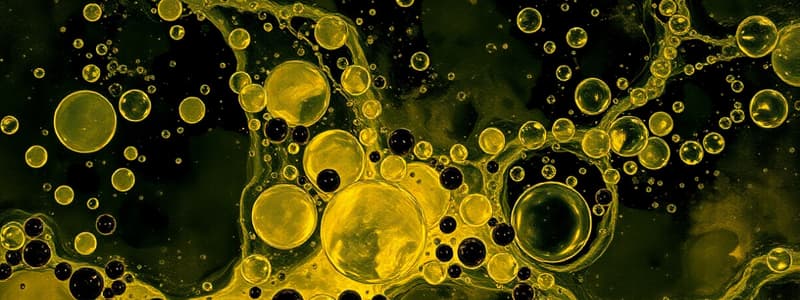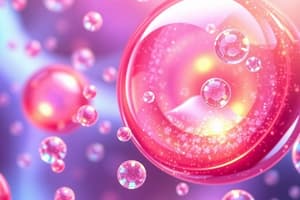Podcast
Questions and Answers
Which statement about lyophobic dispersions is accurate?
Which statement about lyophobic dispersions is accurate?
- They are usually dispersions of metals or inorganic crystals. (correct)
- They have low interfacial free energy.
- They are generally thermodynamically stable.
- They form spontaneously in solution.
What is a key characteristic of lyophilic materials?
What is a key characteristic of lyophilic materials?
- They typically do not disperse when added to a solvent.
- They are stabilized by electrical repulsion.
- They spontaneously disperse in a solvent due to increased entropy. (correct)
- They generally require additional energy to remain dispersed.
How is the stability of lyophobic sols maintained?
How is the stability of lyophobic sols maintained?
- By the presence of stagnant solvent layers.
- Through the presence of electric charges on particle surfaces. (correct)
- By low interfacial surface-free energy.
- Through solvation of surrounding particles.
What is the state of free energy in the formation of lyophobic dispersions?
What is the state of free energy in the formation of lyophobic dispersions?
What primarily controls the stability of lyophilic sols?
What primarily controls the stability of lyophilic sols?
What is the particle size range of colloidal dispersions?
What is the particle size range of colloidal dispersions?
Which of the following represents a colloidal dispersion in a solid state?
Which of the following represents a colloidal dispersion in a solid state?
What is the characteristic of a true solution regarding particle size?
What is the characteristic of a true solution regarding particle size?
Which of the following is a characteristic of coarse dispersions?
Which of the following is a characteristic of coarse dispersions?
In terms of dispersions, which of the following is true about the interaction between the dispersed phase and the continuous medium?
In terms of dispersions, which of the following is true about the interaction between the dispersed phase and the continuous medium?
What type of colloidal dispersion is represented by smoke?
What type of colloidal dispersion is represented by smoke?
Which of the following is NOT a characteristic of colloidal systems?
Which of the following is NOT a characteristic of colloidal systems?
What is the defining range of particle size for suspensions?
What is the defining range of particle size for suspensions?
How does the viscosity of a lyophobic colloidal dispersion compare to that of a lyophilic system?
How does the viscosity of a lyophobic colloidal dispersion compare to that of a lyophilic system?
What effect does the concentration of amphiphiles have on the viscosity of a system?
What effect does the concentration of amphiphiles have on the viscosity of a system?
Why do lyophobic colloidal particles not readily solvate?
Why do lyophobic colloidal particles not readily solvate?
What relationship exists between viscosity and particle concentration in a lyophilic system?
What relationship exists between viscosity and particle concentration in a lyophilic system?
What occurs at sufficiently high concentrations of a dispersed phase in a colloidal system?
What occurs at sufficiently high concentrations of a dispersed phase in a colloidal system?
What is the main characteristic of lyophobic colloids?
What is the main characteristic of lyophobic colloids?
Which of the following correctly defines Stoke's diameter?
Which of the following correctly defines Stoke's diameter?
Which type of colloid consists of particles that swell spontaneously in water?
Which type of colloid consists of particles that swell spontaneously in water?
What type of particles typically compose lyophobic colloids?
What type of particles typically compose lyophobic colloids?
What is a common stabilization requirement for hydrophobic colloids?
What is a common stabilization requirement for hydrophobic colloids?
Which of the following describes the nature of lyophilic colloids?
Which of the following describes the nature of lyophilic colloids?
Which statement is TRUE regarding the dispersed phase in lyophobic colloids?
Which statement is TRUE regarding the dispersed phase in lyophobic colloids?
What do amphiphilic molecules in a colloid typically form?
What do amphiphilic molecules in a colloid typically form?
What role do surfactants play in the stabilization of particles in a colloidal system?
What role do surfactants play in the stabilization of particles in a colloidal system?
What phenomenon occurs when sufficient salt is added to a lyophobic colloid?
What phenomenon occurs when sufficient salt is added to a lyophobic colloid?
How do electrolytes affect lyophobic colloids compared to lyophilic colloids?
How do electrolytes affect lyophobic colloids compared to lyophilic colloids?
What type of interaction helps stabilize colloidal particles by creating a protective solvent sheath?
What type of interaction helps stabilize colloidal particles by creating a protective solvent sheath?
At what condition are proteins more sensitive to the addition of electrolytes?
At what condition are proteins more sensitive to the addition of electrolytes?
What is the effect of hydration on the ions of an electrolyte in colloidal systems?
What is the effect of hydration on the ions of an electrolyte in colloidal systems?
What is formed when lyophilic colloids are salted out?
What is formed when lyophilic colloids are salted out?
How do polyelectrolytes or polymer molecules affect lyophobic colloids?
How do polyelectrolytes or polymer molecules affect lyophobic colloids?
What is the primary characteristic of lyophobic sols?
What is the primary characteristic of lyophobic sols?
What type of charge do the flat 'faces' of clay particles typically carry?
What type of charge do the flat 'faces' of clay particles typically carry?
Which of the following is an example of a lyophobic sol?
Which of the following is an example of a lyophobic sol?
What phenomenon do gels made from hydrophilic particles exhibit due to their structure?
What phenomenon do gels made from hydrophilic particles exhibit due to their structure?
What structural arrangement is formed when the particles of clay flocculate?
What structural arrangement is formed when the particles of clay flocculate?
What is a characteristic feature of hydrophobic colloidal particles in dispersion?
What is a characteristic feature of hydrophobic colloidal particles in dispersion?
How does the shape of colloidal particles affect their interaction with the dispersion medium?
How does the shape of colloidal particles affect their interaction with the dispersion medium?
Which type of interactions stabilize lyophobic sols?
Which type of interactions stabilize lyophobic sols?
Flashcards
Colloidal Dispersion
Colloidal Dispersion
A heterogeneous mixture involving very fine particles known as the dispersed phase suspended throughout a continuous phase, called the dispersion medium.
Dispersed Phase
Dispersed Phase
The substance that gets dispersed into smaller particles within a mixture.
Dispersion Medium
Dispersion Medium
The surrounding substance in which the dispersed phase is suspended.
Foam
Foam
Signup and view all the flashcards
Emulsion
Emulsion
Signup and view all the flashcards
Sol
Sol
Signup and view all the flashcards
Gel
Gel
Signup and view all the flashcards
Solid Sol
Solid Sol
Signup and view all the flashcards
Lyophilic Colloids
Lyophilic Colloids
Signup and view all the flashcards
Lyophobic Colloids
Lyophobic Colloids
Signup and view all the flashcards
Viscosity of Lyophobic Colloids
Viscosity of Lyophobic Colloids
Signup and view all the flashcards
Viscosity of Lyophilic Colloids
Viscosity of Lyophilic Colloids
Signup and view all the flashcards
Gel Formation in Lyophilic Colloids
Gel Formation in Lyophilic Colloids
Signup and view all the flashcards
Association Colloids
Association Colloids
Signup and view all the flashcards
Stabilizing Agents
Stabilizing Agents
Signup and view all the flashcards
Surfactants
Surfactants
Signup and view all the flashcards
Lyophilicity
Lyophilicity
Signup and view all the flashcards
Solvated
Solvated
Signup and view all the flashcards
Aggregation
Aggregation
Signup and view all the flashcards
Stabilization of Lyophobic Colloids
Stabilization of Lyophobic Colloids
Signup and view all the flashcards
Stabilization of Lyophilic Colloids
Stabilization of Lyophilic Colloids
Signup and view all the flashcards
Entropy and Lyophilic Dispersion
Entropy and Lyophilic Dispersion
Signup and view all the flashcards
Coagulation
Coagulation
Signup and view all the flashcards
Protective colloid
Protective colloid
Signup and view all the flashcards
Protective colloid action
Protective colloid action
Signup and view all the flashcards
Salting out
Salting out
Signup and view all the flashcards
Flocculation of Lyophobic Sols
Flocculation of Lyophobic Sols
Signup and view all the flashcards
Card House Floc
Card House Floc
Signup and view all the flashcards
Thixotropy
Thixotropy
Signup and view all the flashcards
Flocculating Gels (e.g., Aluminum Hydroxide, Magnesium Hydroxide)
Flocculating Gels (e.g., Aluminum Hydroxide, Magnesium Hydroxide)
Signup and view all the flashcards
Hydrophilic
Hydrophilic
Signup and view all the flashcards
Shape of Colloidal Particles
Shape of Colloidal Particles
Signup and view all the flashcards
Colloidal Particles in Aqueous Solution
Colloidal Particles in Aqueous Solution
Signup and view all the flashcards
Study Notes
Colloidal Dispersions: Introduction and Properties
- Colloidal dispersions are heterogeneous systems composed of a dispersed phase (very fine particles) and a dispersion medium (continuous phase).
- Particle sizes in disperse systems (true solution, colloidal dispersions, fine dispersions, coarse dispersions) are categorized according to specific ranges, with colloids falling between true solutions and fine dispersions: <1nm (true solution), 1nm - 500nm = 0.5µm (colloidal dispersions), 500nm = 0.5µm - 10µm (fine dispersions), 10 - 50µm (coarse dispersions).
- Colloidal systems are classified based on: the physical state of the dispersed phase and dispersion medium; particle size; and the interaction between the dispersed phase and the dispersion medium.
- Common examples of colloidal dispersions include:
- Gas dispersed in gas: Fog, mist, smoke (aerosols)
- Liquid dispersed in gas: Fog, mist, aerosols (aerosols)
- Solid dispersed in gas: Smoke, dust
- Liquid dispersed in liquid: Emulsions (milk, mayonnaise)
- Solid dispersed in liquid: Sols (blood, antacids), suspensions
- Gas dispersed in liquid: Foam (whipped cream)
- Liquid dispersed in solid: Solid foam (styrofoam)
- Solid dispersed in solid: Gel (agar, gelatin)
- Solid dispersed in solid: solid sol & suspension
Particle Size and Size Distribution
- Colloidal particles range in size from 1-1000nm, distinguishing them from larger suspensions(>1000nm) and smaller true solutions(<1nm).
- Size measurements can be determined through osmotic pressure, sedimentation, and light scattering
- Size is determined by diameter, but asymmetrical particles are measured by Stokes' diameter.
- The size of particles is important for behavior, particularly in the context of absorption for solid aerosols, which must be between 1-5µm and not exceed 10µm.
Interaction Between Dispersed Phase and Dispersion Medium
- Lyophilic colloids ("liquid loving"): have strong attractions between the dispersed phase and the dispersion medium.
- Lyophobic colloids ("liquid hating"): have weak interactions between the dispersed phase and the dispersion medium, thus needing stabilizing agents.
- Association/amphiphilic colloids: dispersed phase consists of aggregates (micelles) of small organic molecules or ions, and their size is below the colloidal range. A portion of them is either hydrophilic or lipophilic, depending on the medium (aqueous, non-aqueous).
- Water-based colloids with inorganic dispersed phases are lyophobic (e.g., gold).
- Some lyophobic colloids have lyophilic properties (e.g., silica and alumina hydrosols).
Dispersion Medium is Water
- Hydrophilic colloids, in water, disperse spontaneously and have high affinity (swell).
- Hydrophobic colloids, in water, are unstable and need stabilizing agents.
Lyophilic and Lyophobic Preparations
- Lyophobic colloids cannot be directly prepared by mixing; special methods and stabilizers are needed.
- Mechanical reduction methods (colloidal mill, hammer, ball jet) or ultrasonic vibration reduce particle size.
- Condensation methods (physical and chemical, using processes like displacement, hydrolysis, and oxidation-reduction) produce the colloid.
- Lyophilic colloids are generally made directly by mixing.
Colloid Properties for Molecular Weight Determination
- Properties for molecular weight determination include Tyndall effect, viscosity, and osmotic pressure.
Electrical Properties of Colloids
- Most surfaces acquire a surface charge when in contact with an aqueous medium, due to: (1.) ion dissolution; (2.) ionization of surface groups; (3.) ion adsorption.
- Particles of a given colloid have the same charge, repelling one another. Neutralized charges can cause precipitation.
- Electrophoresis is used for measuring zeta potential (charge of colloidal particles).
Terminology and Additional Properties
- Imbibition: Taking up liquid by a solid or gel, without considerable volume increase.
- Swelling: Taking up liquid by a gel, with volume increase.
- Syneresis: A great interaction between dispersed phase particles and dispersed medium squeezed out as droplets, causing gel shrinkage.
- Xerogels are gels with the liquid vehicle removed, leaving a polymer framework.
- Examples of xerogels include sheet gelatin, acacia tears, and tragacanth flakes.
- Lyophobic sols (e.g., Aluminum Hydroxide Gel, USP) can be flocculated, forming a 2-phase system where the sol appears as a continuous floccule.
- Clay suspensions are an example of a lyophobic system composed of plate-like particles held together by weak forces (e.g., van der Waals forces).
- Properties such as flow, sedimentation, and osmotic pressure are influenced by colloidal particle shapes.
Studying That Suits You
Use AI to generate personalized quizzes and flashcards to suit your learning preferences.





